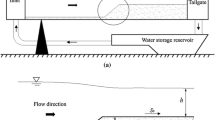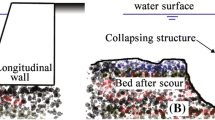Abstract
The drop structure will fail as a result of local scoring downstream. This paper discusses the influence of a drop structures’ upstream slope to local scour. Empirical equations of the scour hole were developed by laboratory experiment, theoretical assumptions, and regression analysis. These equations include the maximum scour depth and length during the scouring period, the maximum equilibrium scour depth and length, and the unit width scour rate. The four channel slopes (0%, 2%, 4%, and 6%) before the drop structure has been included in the analysis. A series of laboratory experiments were conducted to obtain 48 groups of experiments and 419 scour hole profiles during the scouring period. The material used in the scour section is uniform non-cohesive and with a median diameter of d 50 = 0.5 mm. The results have been used to develop empirical equations via regression analysis to determine the coefficients of theoretical equations. The high correlation coefficient indicates that the equations developed in this study are suitable for verifying the characteristics of a scour hole at drop structure in the sloped channel. The semi-empirical equation is more accurate than the empirical equation. Compared to a horizontal channel, a sloped channel tends to cause a greater equilibrium maximum scour length, shorter equilibrium maximum scour depth, and faster unit-wide scour rate.
Similar content being viewed by others
Abbreviations
- A s :
-
Dimensionless unit-wide scour volume of the scour hole profile -
- A st :
-
Scour hole area at a given duration L 2
- A se :
-
Scour hole area at equilibrium scour state L 2
- C 1 :
-
the shape coefficient -
- C 2 :
-
the distance coefficient -
- D :
-
Downstream channel grain size L
- DSR:
-
Dimensionless scour rate of unit width -
- EMSD:
-
Equilibrium maximum scour depth L
- EMSL:
-
Equilibrium maximum scour length L
- g :
-
Gravitational acceleration L 2 T −1
- h :
-
Drop height L
- h se :
-
The EMSD L
- h st :
-
The maximum scour depth at a given time duration L
- h t :
-
Tail water height L
- L it :
-
The horizontal distance from the toe of the drop structure to the EMSD L
- L st :
-
The horizontal distance from the toe of the drop structure to the MSD at a given time duration L
- MSD:
-
Maximum scour depth L
- MSL:
-
maximum scour length L
- N d :
-
Drop Number -
- q :
-
Unit-wide discharge L 2 T −1
- q se :
-
Mean unit-wide scouring rate for the duration from the beginning to the end of scour development L 2 T −1
- q st :
-
Unit-wide scouring rate at a given duration L 2 T −1
- S :
-
Slope of the upstream channel -
- t :
-
The duration since the scouring starts T
- t e :
-
The duration since the equilibrium scour hole is developed T
- T e :
-
Time of the equilibrium scour hole T
- s :
-
Slope of the upstream channel -
- SR:
-
Scour rate of unit width L 2 T −1
- UBS:
-
Upstream bed slope -
- β :
-
Slope factor -
- δ :
-
Slope-effect ratio -
- λ :
-
Scouring process factor -
References
Bennett SJ, Alonso CV, Prasad SN, Römkens MJ (2000) Experiments on headcut growth and migration in concentrated flows typical of upland areas. Water Resources Research 36(7): 1911–1922. DOI: 10.1029/2000WR900067
Bormann NE, Julien PY (1991) Scour downstream of grade-control structures. Journal of Hydraulic Engineering 117(5): 579–594.
Chanson H. (1995). Hydraulic design of stepped cascades, channels, weirs and spillways. Pergamon, Oxford, UK.
Chen JY (1987). Localized scour profiles by free over-fall flow. Taiwan Water Conservancy Quarterly 35(1): 35–53 (In Chinese)
Chen JY, Peng SH, Jong WC (1994) Study on the scour rate below weirs by free overfall flows. Journal of Chinese Soil and Water Conservation 25(3): 135–142 (In Chinese)
Chen JY, Hong YM (2001) Characteristics of check dam scour hole by free overfall flow. Journal of the Chinese Institute of Engineers 24(6): 673–680. DOI: 10.1080/02533839.2001.9670664
Chen JY, Huang HS, Hong YM, Liu SI (2011) The impact characteristics analysis of free over-fall flow on downstream channel bed. Journal of the Chinese Institute of Engineers 34(3): 403–413. DOI:10.1080/02533839.2011.565616
D'Agostino V, Ferro V (2004) Scour on alluvial bed downstream of grade-control structures. Journal of Hydraulic Engineering 130(1): 24–37. DOI: 10.1061/(ASCE)0733-9429
Farhoudi J, Smith KV (1985) Local scour profiles downstream of hydraulic jump. Journal of hydraulic research 23(4): 343–358. DOI: 10.1080/00221688509499344
Ghodsian M, Faradonbeh AA (2002) Scour hole characteristics below free overfall spillway. International Journal of Sediment Research 17(4): 304–313.
Hong YM, Huang HS, Wan S (2010) Drop characteristics of free-falling nappe for aerated straight-drop spillway. Journal of Hydraulic Research 48(1): 125–129. DOI:10.1080/00221680903568683
Institute of Agricultural Engineering (1980) The hydraulic characteristics experiment of check dam and river regulation. National Taiwan University, Chinese Taipei (In Chinese)
Liu SI, Chen JY, Hong YM, et al. (2014) Impact Characteristics of Free Over-Fall in Pool Zone with Upstream Bed Slope, Journal of Marine Science and Technology 22(4): 476–486. DOI: 10.6119/JMST-013-0604-1
Pan HL, Yang S, Ou GQ, Huang JC (2013) Local scour and the laws of scour pit’s shape downstream of debris flow sabo dam. Journal of Mountain Science 10(6): 1063–1073. DOI: 10.1007/s11629-013-2362-9
Rand W (1955) Flow geometry at straight drop spillways. Journal of Hydraulic Division, ASCE 81(791): 1–13.
Rouse H (1940) Criteria for Similarity in the Transportation of Sediment. University of Iowa Studies in Engineering 20: 33–49.
Stein OR, Julien PY, Alonso CV (1993) Mechanics of jet scour downstream of a headcut. Journal of hydraulic research 31(6): 723–738. DOI: 10.1080/00221689309498814
Sung TC (2014) Experimental study on scour mechanism and its application to non-horizontal drop structure with free overfall. Master Thesis, Department of Civil Engineering, National Chung-Hsing University, Chinese Taipei (In Chinese)
Acknowledgment
The authors would like to appreciate the research support from Ministry of Science and Technology of Chinese Taipei, with the project no. 104-2313-B-343-001.
Author information
Authors and Affiliations
Corresponding author
Additional information
http://orcid.org/0000-0003-3336-0558
http://orcid.org/0000-0001-8943-411X
http://orcid.org/0000-0002-9007-3347
Rights and permissions
About this article
Cite this article
Chen, Jy., Hsu, Hh. & Hong, Ym. The influence of upstream slope on the local scour at drop structure. J. Mt. Sci. 13, 2237–2248 (2016). https://doi.org/10.1007/s11629-015-3790-5
Received:
Revised:
Accepted:
Published:
Issue Date:
DOI: https://doi.org/10.1007/s11629-015-3790-5




